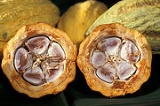
Cocoa
Overview
Cocoa bean is the dried and fully fermented fatty seed
of Theobroma cacao, from which cocoa solids
and cocoa butter
are extracted. They are the basis of chocolate
, as well as many Mesoamerican foods such as mole sauce and tejate
.
A cocoa pod (fruit) has a rough leathery rind about 3 cm thick (this varies with the origin and variety of pod). It is filled with sweet, mucilaginous
pulp (called 'baba de cacao' in South America) enclosing 30 to 50 large seeds that are fairly soft and white to pale lavender in color.
Seed
A seed is a small embryonic plant enclosed in a covering called the seed coat, usually with some stored food. It is the product of the ripened ovule of gymnosperm and angiosperm plants which occurs after fertilization and some growth within the mother plant...
of Theobroma cacao, from which cocoa solids
Cocoa solids
Cocoa solids are the low-fat component of chocolate. When sold as an end product, it may also be called cocoa powder, cocoa, and cacao....
and cocoa butter
Cocoa butter
Cocoa butter, also called theobroma oil, is a pale-yellow, pure edible vegetable fat extracted from the cocoa bean. It is used to make chocolate, biscuits, and baked goods, as well as some pharmaceuticals, ointments, and toiletries...
are extracted. They are the basis of chocolate
Chocolate
Chocolate is a raw or processed food produced from the seed of the tropical Theobroma cacao tree. Cacao has been cultivated for at least three millennia in Mexico, Central and South America. Its earliest documented use is around 1100 BC...
, as well as many Mesoamerican foods such as mole sauce and tejate
Tejate
Tejate is a maize and cacao beverage traditionally made in Oaxaca, Mexico, originating from pre-Hispanic times. It remains very popular among the indigenous Mixtec and Zapotec peoples, especially in rural areas. It's also very popular for anyone who lives in Oaxaca and the surrounding regions...
.
A cocoa pod (fruit) has a rough leathery rind about 3 cm thick (this varies with the origin and variety of pod). It is filled with sweet, mucilaginous
Mucilage
Mucilage is a thick, gluey substance produced by most plants and some microorganisms. It is a polar glycoprotein and an exopolysaccharide.It occurs in various parts of nearly all classes of plant, usually in relatively small percentages, and is frequently associated with other substances, such as...
pulp (called 'baba de cacao' in South America) enclosing 30 to 50 large seeds that are fairly soft and white to pale lavender in color.
Unanswered Questions
Discussions

